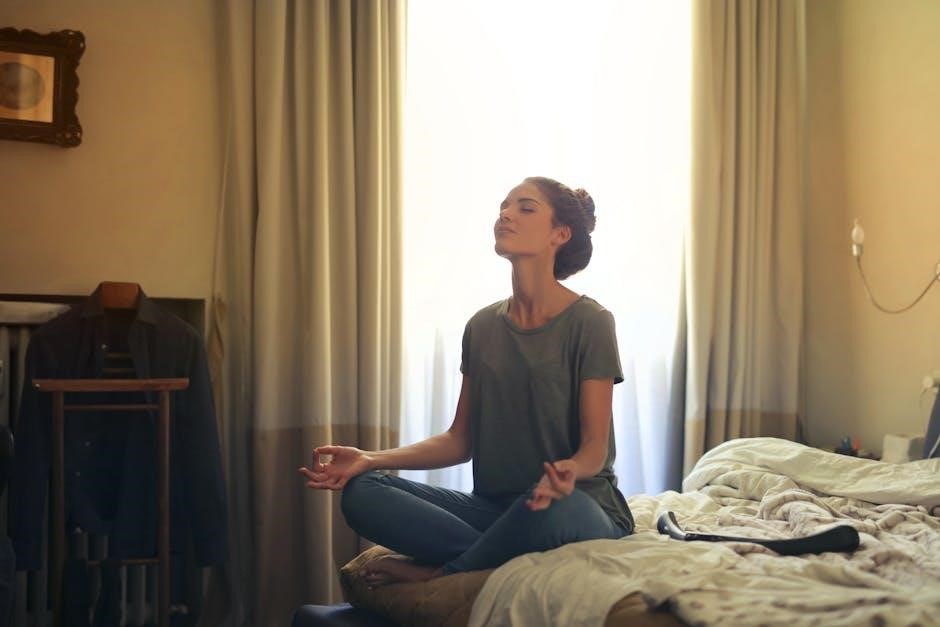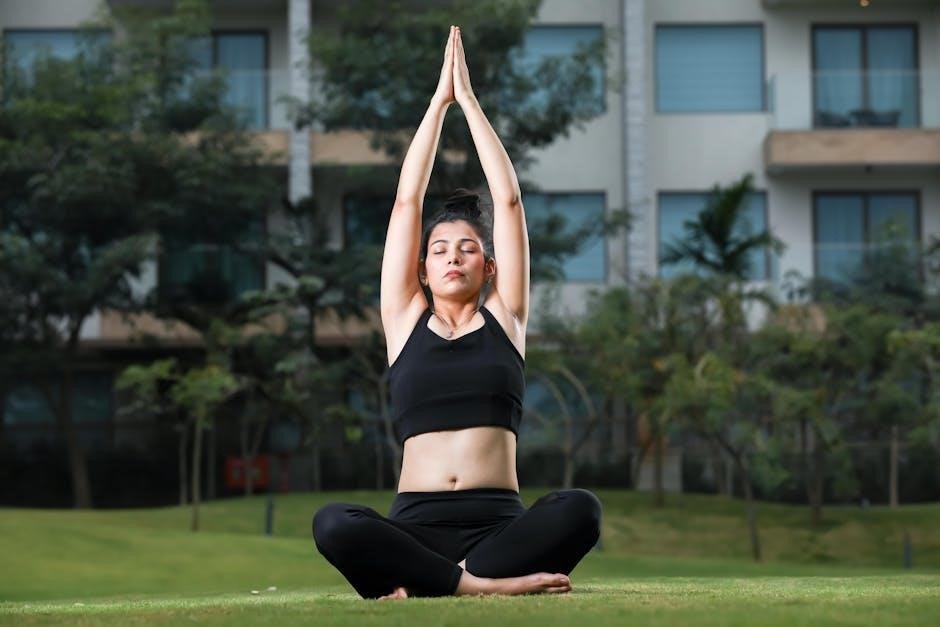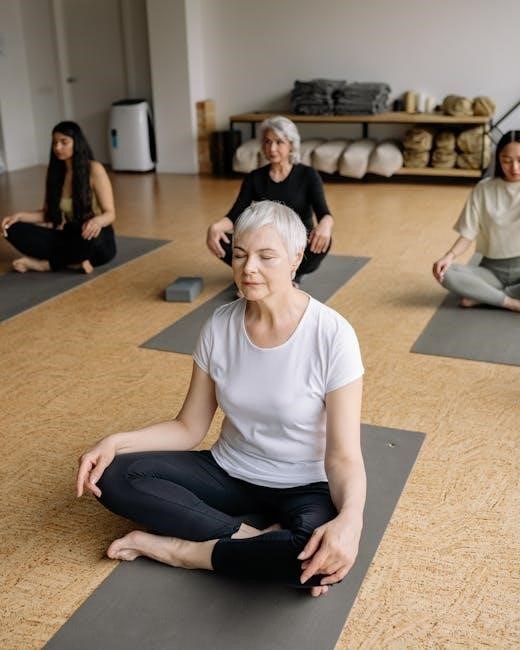
buteyko breathing pdf
Developed by Professor Konstantin Buteyko, this method focuses on nasal breathing, breath control, and relaxation to optimize oxygen delivery and reduce respiratory issues like asthma and stress․
What is Buteyko Breathing?
Buteyko Breathing is a holistic respiratory method developed by Professor Konstantin Buteyko, focusing on nasal breathing, breath control, and relaxation to restore optimal breathing patterns․ It aims to reduce over-breathing, which can disrupt carbon dioxide levels in the blood, often linked to respiratory issues like asthma and allergies․ The technique emphasizes slow, calm breathing through the nose, along with breath-holding exercises to improve lung capacity and oxygen delivery․ Originating in the 1950s in Russia, it has gained global recognition for its natural approach to managing respiratory health and stress․ Buteyko Breathing is supported by scientific studies and is widely used by healthcare professionals to help individuals achieve better respiratory function and overall well-being․
History and Development of the Buteyko Method
The Buteyko Breathing Method was developed in the 1950s by Ukrainian physician Professor Konstantin Buteyko․ Initially met with skepticism, it gained recognition for its holistic approach to respiratory health․ Buteyko, a medical researcher, observed that over-breathing (hyperventilation) could lead to respiratory issues like asthma․ He designed the method to normalize breathing patterns by promoting nasal breathing, breath control, and relaxation․ Over the decades, the technique was refined and validated through clinical studies, earning acceptance worldwide․ Today, it is widely used by healthcare professionals and has been promoted by advocates like Patrick McKeown, who popularized it globally․ The method remains a cornerstone of natural respiratory care, emphasizing self-managed exercises to improve oxygen delivery and reduce symptoms of chronic respiratory conditions․ Its enduring popularity stems from its non-invasive, drug-free approach, supported by both scientific evidence and anecdotal success stories․

Key Principles of Buteyko Breathing
Nasal breathing is fundamental, as the nose filters, warms, and humidifies air․ Breath-holding exercises help regulate breathing depth and rhythm, while relaxation promotes diaphragmatic breathing and reduces over-breathing․

Nasal Breathing: The Foundation of Buteyko
Nasal breathing is the cornerstone of the Buteyko method, emphasizing that the nose is designed for breathing while the mouth is for eating, drinking, and speaking․ By exclusively using the nose, air is naturally filtered, warmed, and humidified, which optimizes oxygen absorption and minimizes irritation to the respiratory tract․ The Buteyko technique encourages users to switch from mouth to nasal breathing, even during exercise or sleep, to promote healthier breathing patterns․ This shift reduces over-breathing, associated with hyperventilation, and helps restore a balanced breathing rhythm․ nasal breathing also engages the diaphragm more effectively, enhancing lung capacity and overall respiratory efficiency․ The method teaches that consistent nasal breathing is essential for achieving the full benefits of the Buteyko approach, including improved asthma management and reduced respiratory discomfort․
Breath Holding Exercises and Their Importance

Breath holding exercises, such as the Control Pause (CP) and Body Oxygen Level Test (BOLT), are central to the Buteyko method․ These exercises involve holding the breath after a gentle exhale to assess and improve oxygen levels in the body․ The CP measures how long one can comfortably hold their breath, reflecting respiratory efficiency and oxygen retention․ A higher CP indicates better breathing patterns and reduced hyperventilation․ Regular practice of these exercises helps retrain the body to breathe more efficiently, reducing over-breathing and its associated symptoms․ By slowing down breathing and increasing carbon dioxide levels, the exercises enhance oxygen delivery to tissues and organs․ This approach is particularly beneficial for asthma management, as it strengthens respiratory control and reduces reliance on medication․ The Buteyko method’s focus on breath holding aligns with scientific studies, demonstrating its effectiveness in improving respiratory health and overall well-being․
Relaxation and Diaphragmatic Breathing
Relaxation and diaphragmatic breathing are fundamental components of the Buteyko method, aiming to restore natural breathing patterns and reduce stress․ By engaging the diaphragm, the primary muscle for breathing, this technique promotes deeper, more efficient breaths․ Relaxation helps calm the nervous system, lowering stress hormones like cortisol, which can exacerbate breathing difficulties․ Diaphragmatic breathing strengthens the diaphragm, improving lung capacity and oxygen exchange․ This practice also helps reduce hyperventilation, a common issue in respiratory conditions like asthma․ Regular relaxation exercises, combined with diaphragmatic breathing, create a balanced breathing pattern, enhancing overall respiratory health and energy levels․ The Buteyko method emphasizes the importance of a relaxed state to achieve optimal breathing efficiency, making it easier to manage stress and improve long-term well-being․ This holistic approach addresses both physical and mental aspects of breathing, providing a comprehensive solution for better health outcomes․
Benefits of the Buteyko Breathing Technique
The Buteyko method enhances respiratory health, reduces stress, and improves oxygen delivery․ It alleviates asthma symptoms, boosts energy levels, and promotes relaxation, leading to better overall well-being and vitality․
Improvements in Respiratory Health
The Buteyko Breathing Technique significantly enhances respiratory health by addressing hyperventilation and promoting nasal breathing․ This method strengthens the respiratory system, improving lung function and reducing symptoms of asthma and allergies․ By normalizing breathing patterns, it reduces airway constriction and inflammation, making it easier to breathe․ Regular practice also boosts oxygenation of the body, leading to better overall respiratory efficiency․ Studies have shown that Buteyko breathing can decrease asthma medication use and severity of symptoms․ Additionally, it helps manage chronic respiratory conditions by teaching individuals to breathe more calmly and effectively․ Over time, this technique fosters healthier breathing habits, reducing the impact of respiratory disorders and improving quality of life․ The focus on nasal breathing ensures proper filtration and humidification of air, further protecting the lungs and airways from irritation and damage․ This holistic approach makes the Buteyko method a valuable tool for long-term respiratory health improvement․
Reduction in Stress and Anxiety
Buteyko Breathing is highly effective in reducing stress and anxiety by promoting relaxation and balancing the body’s nervous system․ The technique focuses on slowing down breathing, which activates the parasympathetic nervous system, calming the mind and body․ By reducing hyperventilation, Buteyko helps lower stress hormones like cortisol, creating a sense of calm and emotional stability․ Regular practice can also improve sleep quality, further reducing anxiety levels․ The method teaches individuals to manage stress triggers more effectively by controlling their breath, leading to long-term emotional resilience․ Many practitioners report feeling more centered and less reactive to stressful situations after incorporating Buteyko breathing into their daily routine․ This makes it a valuable tool for both mental and physical well-being, offering a natural way to alleviate stress and anxiety without medication․
Enhanced Oxygen Delivery and Energy Levels
Buteyko Breathing significantly enhances oxygen delivery and boosts energy levels by optimizing breathing patterns․ The method emphasizes nasal breathing, which warms and humidifies the air, making oxygen absorption more efficient․ By reducing hyperventilation, Buteyko Breathing increases carbon dioxide levels in the blood, improving blood flow and oxygen delivery to tissues and organs․ This leads to increased energy levels and improved physical performance․ The technique also promotes better sleep quality, further contributing to enhanced vitality․ Regular practice strengthens the body’s ability to utilize oxygen effectively, reducing fatigue and improving overall well-being․ Many practitioners report feeling more energetic and mentally clarity after adopting the Buteyko method․ This natural approach to breathing offers a sustainable way to enhance oxygen delivery and maintain consistent energy levels throughout the day․

How to Practice Buteyko Breathing
Find a quiet space, focus on nasal breathing, and practice breath-holding exercises․ Start with short sessions, gradually increasing duration․ Regular practice helps develop consistent breathing patterns and improves oxygenation․
Step-by-Step Guide to the Buteyko Technique
Begin by finding a quiet, comfortable environment․ Sit or lie down and close your mouth․ Inhale and exhale gently through your nose․ Practice nasal breathing exclusively․ Next, exhale slowly and pinch your nose shut with your fingers․ Hold your breath until you feel a natural urge to breathe․ This is the Control Pause (CP)․ Record this time․ Repeat the process regularly․ Gradually increase your CP over time․ Incorporate relaxation techniques to avoid tension․ Practice daily, ideally in the morning and before bed․ Over time, this method helps normalize breathing patterns, reducing over-breathing and improving oxygen delivery․ Consistency is key to achieving long-term benefits․

Control Pause (CP) and Body Oxygen Level Test (BOLT)
The Control Pause (CP) is a key measurement in the Buteyko method, assessing breath-holding tolerance after exhalation․ To measure CP, sit comfortably, inhale gently, exhale slowly, and pinch your nose․ Hold your breath until you feel a strong urge to breathe․ The time taken to reach this urge is your CP․ Aim to gradually increase this duration․ The Body Oxygen Level Test (BOLT) is similar but performed upon waking to measure baseline oxygen levels․ Both tests help evaluate progress and guide practice․ Regular measurement of CP and BOLT provides insights into breathing efficiency and overall health improvements․ These exercises are foundational to the Buteyko technique, helping reduce hyperventilation and enhance oxygen delivery to the body․ Consistent practice is essential for achieving optimal results․ Over time, higher CP and BOLT scores indicate better respiratory function and improved well-being․

Regular Practice and Daily Routine
Consistency is crucial for mastering the Buteyko breathing technique․ Start with short practice sessions of 5-10 minutes, gradually increasing as you become more comfortable․ Begin by focusing on nasal breathing throughout the day, ensuring inhalation and exhalation occur solely through the nose․ Practice breath-holding exercises like the Control Pause (CP) and Body Oxygen Level Test (BOLT) daily to monitor progress․ Incorporate relaxation techniques, such as diaphragmatic breathing, to enhance calmness and reduce stress․ Set aside dedicated time each morning and evening for focused practice, creating a quiet and distraction-free environment․ Regularity helps retrain breathing patterns, leading to improved respiratory efficiency and overall well-being․ Over time, integrate Buteyko exercises into daily activities, such as during walks or before meals, to reinforce proper breathing habits․ Patience and consistency are key to achieving long-term benefits and making Buteyko breathing a natural part of your routine․

Scientific Evidence and Research
Clinical studies demonstrate the Buteyko method’s effectiveness in reducing asthma symptoms and medication use, supported by research on breath control and nasal breathing benefits for respiratory health and oxygenation․
Studies Supporting the Buteyko Method
Multiple clinical trials have validated the Buteyko method’s efficacy in managing asthma and respiratory disorders․ Research published in medical journals highlights significant reductions in asthma symptoms and medication use․ A study conducted in 2002 at the Buteyko Clinic demonstrated improved lung function and quality of life in participants․ Another study published in 2015 found that Buteyko breathing exercises decreased hyperventilation and enhanced oxygen delivery․ These findings are supported by decades of research showing consistent benefits for respiratory health․ The method’s focus on nasal breathing and breath control has been scientifically proven to stabilize breathing patterns and improve overall well-being․ Such evidence underscores the Buteyko method’s credibility as a complementary therapy for respiratory conditions․
Comparison with Other Breathing Techniques
The Buteyko method differs from other breathing techniques like diaphragmatic breathing or yoga breathwork by its focus on nasal breathing and breath-holding exercises․ Unlike holistic approaches that emphasize spiritual connection, Buteyko is grounded in physiological principles, targeting over-breathing and hyperventilation․ While techniques such as Holotropic Breathwork encourage rapid breathing for emotional release, Buteyko promotes controlled, slower breathing to restore natural respiratory balance․ Its structured exercises, like the Control Pause and BOLT, set it apart from more flexible methods; Studies show Buteyko’s effectiveness in reducing asthma symptoms, making it a preferred choice for respiratory conditions․ Overall, Buteyko offers a unique, evidence-based approach that complements medical treatments, distinguishing it from more generalized breathing practices․

Buteyko Breathing for Specific Conditions
Buteyko Breathing is widely used to manage asthma, allergies, and respiratory disorders․ It reduces symptoms like wheezing and breathlessness, improving oxygen delivery and overall well-being for individuals with chronic conditions․
Asthma Management and Symptom Reduction
Buteyko Breathing is highly effective for asthma management, reducing symptoms such as wheezing, coughing, and shortness of breath․ By promoting nasal breathing and controlled breath-holding exercises, it helps normalize breathing patterns, decreasing airway inflammation and hyperactivity․ Studies show that regular practice can significantly reduce asthma medication use and improve quality of life․ The technique teaches individuals to breathe more efficiently, preventing hyperventilation and restoring proper oxygen and carbon dioxide balance․ This approach is particularly beneficial for those with chronic asthma, offering a drug-free alternative to manage symptoms and enhance respiratory function․ Many healthcare professionals recommend Buteyko as a complementary therapy for asthma, emphasizing its ability to empower individuals to control their condition naturally․ With consistent practice, users often experience fewer asthma attacks and improved overall well-being․
Allergies and Respiratory Disorders
Buteyko Breathing offers significant benefits for managing allergies and respiratory disorders by addressing the root causes of breathing inefficiencies․ The method emphasizes nasal breathing, which naturally filters, warms, and humidifies the air, reducing irritant exposure․ By practicing controlled breathing exercises, individuals can strengthen their respiratory system, improving lung capacity and function․ This approach also helps reduce inflammation and hyperresponsiveness in the airways, common in conditions like chronic rhinitis or sinusitis․ Many users report a decrease in allergic reactions and sinus congestion after adopting the technique․ Additionally, Buteyko Breathing helps regulate the body’s immune response, making it less reactive to allergens․ Overall, this method provides a holistic, non-invasive solution for managing allergies and respiratory disorders, enhancing overall respiratory health and well-being․ Regular practice can lead to long-term improvements, reducing reliance on medications and improving quality of life․

Buteyko Breathing Exercises and Resources
Downloadable PDF guides, video tutorials, and online courses provide comprehensive instruction in Buteyko techniques, helping users master breath control, nasal breathing, and relaxation for improved respiratory health and well-being․
Downloadable PDF Guides and Manuals
Downloadable PDF guides and manuals on Buteyko breathing provide comprehensive instruction for mastering the technique․ These resources include detailed breathing exercises, step-by-step instructions, and methods to improve lung capacity․ Many guides offer practical advice for incorporating Buteyko into daily routines, such as nasal breathing practices and relaxation techniques․ They often feature illustrations and charts to help users understand proper posture, breath control, and progress tracking․ Some manuals also include the Control Pause (CP) and Body Oxygen Level Test (BOLT) to assess breathing efficiency․ These PDFs are widely available online, with many free to download, making them accessible for those seeking to learn the method․ They are ideal for both beginners and advanced practitioners, offering a structured approach to achieving optimal breathing and overall health․ Additionally, these guides are frequently used by Buteyko practitioners and clinics to support their teachings, ensuring a consistent and evidence-based learning experience․
Video Tutorials and Online Courses
Video tutorials and online courses on Buteyko breathing offer interactive and visual guidance for mastering the technique․ Platforms like YouTube, Udemy, and Skillshare host a variety of instructional videos led by certified practitioners․ These resources provide step-by-step demonstrations of exercises, including nasal breathing, breath-holding practices, and relaxation techniques․ Many courses include downloadable materials, such as PDF guides, to complement the video content․ They cater to both beginners and advanced learners, offering tips for integrating Buteyko into daily routines․ The visual format helps users understand proper posture, breath control, and the progression of exercises like the Control Pause (CP) and Body Oxygen Level Test (BOLT)․ Online courses also emphasize the importance of consistent practice and offer tracking tools to monitor improvement․ With flexible access, these resources make it easier for individuals to learn and benefit from the Buteyko method at their own pace․
The Buteyko Breathing Technique offers a natural, evidence-based approach to improving respiratory health, reducing stress, and enhancing overall well-being․ Its simplicity and effectiveness make it a valuable practice for many․
The Future of Buteyko Breathing in Healthcare
The Buteyko Breathing Technique is gaining recognition as a complementary approach in healthcare, particularly for respiratory and stress-related conditions․ Its non-invasive nature and proven benefits make it a promising tool for integrating breathing therapy into modern medicine․ As research continues to validate its effectiveness, healthcare providers are likely to adopt it more widely․ The method’s focus on nasal breathing, breath control, and relaxation aligns with growing interest in holistic health practices․ With advancements in digital health, Buteyko exercises may become more accessible through apps and online platforms, reaching a broader audience․ This technique has the potential to reduce reliance on medications and improve quality of life for millions, making it a significant player in the future of respiratory care and overall well-being․